What Colors Were Popular in the 1980s
Costume and fashion in the 1980s

Fashion of the 1980s placed heavy emphasis on cheap clothes and fashion accessories and very big poofy hair. Apparel tended to be very bright and vivid in appearance.Punk fashion began as a reaction against both the hippie movement of the past decades and the materialist values of the current decade.[2] The first half of the decade was relatively tame in comparison to the second half, which is when the iconic 1980s color scheme had come into popularity.
Hair in the 1980s was typically big, curly, bouffant and heavily styled. Television shows such as Dynasty helped popularize the high volume bouffant and glamorous image associated with it.[3] [4] Women in the 1980s wore bright, heavy makeup. Everyday fashion in the 1980s consisted of light-colored lips, dark and thick eyelashes, and pink or red rouge (otherwise known as blush).[5] [6]
Some of the top fashion models of the 1980s were Brooke Shields, Christie Brinkley, Gia Carangi, Joan Severance, Kim Alexis, Carol Alt, Yasmin Le Bon, Renée Simonsen, Kelly Emberg, Ines de la Fressange, Tatjana Patitz, Elle Macpherson, and Paulina Porizkova.[ citation needed ]
Women's fashion [edit]
Early 1980s (1980–83) [edit]

Minimalism [edit]

Young woman in 1980 wearing a low-cut spaghetti strap dress.
- The early 1980s witnessed a backlash against the brightly colored disco fashions of the late 1970s in favor of a minimalist approach to fashion, with less emphasis on accessories. In the US and Europe practicality was considered just as much as aesthetics. In the UK and America clothing colors were subdued, quiet and basic; varying shades of brown, tan, cream, and orange were common.[7]
- Fashionable clothing in the early 1980s included unisex and gender-specific attire. Widespread fashions for women in the early 1980s included sweaters (including turtleneck, crew neck, and v-neck varieties); fur-lined puffer jackets; tunics; faux-fur coats; velvet blazers; trench coats (made in both fake and real leather);[7] crop tops; tube tops; knee-length skirts (of no prescribed length, as designers opted for choice); loose, flowy, knee-length dresses (with high-cut and low-cut necklines, varying sleeve lengths, and made in a variety of fabrics including cotton, silk, satin, and polyester); high-waisted loose pants; embroidered jeans; leather pants; and designer jeans.[7] [8] [9] Women's pants of the 1980s were, in general, worn with long inseams, and by 1982 the flared jeans of the 70s had gone out of fashion in favor of straight leg trousers.
- From 1980 until 1983 popular women's accessories included thin belts, knee-high boots with thick kitten heels, sneakers, jelly shoes (a new trend at the time),[10] mules, round-toed shoes and boots, jelly bracelets (inspired by Madonna in 1983),[11] shoes with thick heels, small, thin necklaces (with a variety of materials, such as gold and pearls), and small watches.[7]
Aerobics craze [edit]
- The fitness craze of the 1970s continued into the early 1980s. General women's street-wear worn in the early 1980s included ripped sweatshirts,[12] tights, sweatpants,[13] and tracksuits (especially ones made in velour).[7]
- Athletic accessories were a massive trend in the early 1980s, and their popularity was largely boosted by the aerobics craze. This included leg warmers, wide belts,[13] elastic headbands, and athletic shoes known as 'sneakers' in the US[14] or 'trainers' in the UK.[15]
Professional fashion [edit]
- In the 1970s, more women were joining the work force, so, by the early 1980s, working women were no longer considered unusual. As a way to proclaim themselves as equals in the job market, women started to dress more seriously at work. Popular clothes for women in the job market include knee-length skirts, wide-legged slacks, a matching blazer, and a blouse of a different color. Kitten-heeled shoes were often worn.[7] Formal shoes became more comfortable during this period in time, with manufacturers adding soles that were more flexible and supportive.[16] The shoes with moderately spiked heels and relatively pointy toes from the very late 1970s remained a fashion trend.
Mid 1980s (1984–86) [edit]
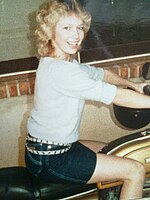
A young woman from the mid 1980s wearing a denim mini skirt with two thin belts.
Bright colors [edit]

- Women's fashion in the early 1980s became more colorful around 1982. This included long wool coats, long flared skirts, slim miniskirts, slightly tapered pants and stirrup ones, designer jeans,[8] spandex cycling shorts,[17] extremely long and bulky sweaters, jumpsuits, pastel colors, "off-the-shoulder" sweatshirts over tight jeans, leather trenchcoats, fur coats, extremely large scarves, beanies, leather gloves, and dresses worn with wide or thin belts. The aerobics craze of the early 1980s continued into the mid 1980s, but the clothes became more colorful than they were before.
- Women's shoes of the mid 1980s included strappy sandals, kitten-heeled sandals, pumps, ballet flats, boat shoes, slouchy flat boots and Keds.[7]
- In the 1980s, rising pop star Madonna proved to be very influential to female fashions. She first emerged on the dance music scene with her "street urchin" look consisting of short skirts worn over leggings, necklaces, rubber bracelets, fishnet gloves, hairbows, long layered strings of beads, bleached, untidy hair with dark roots, headbands, and lace ribbons. In her "Like a Virgin" phase, millions of young girls around the world emulated her fashion example that included brassieres worn as outerwear, huge crucifix jewelry, lace gloves, tulle skirts, and boytoy belts.
- Gloves (sometimes laced or fingerless) were popularized by Madonna, as well as fishnet stockings and layers of beaded necklaces. Short, tight Lycra or leather miniskirts and tubular dresses were also worn, as were cropped bolero-style jackets. Black was the preferred color. With the new fashion's most extreme forms, young women would forgo conventional outer-garments for vintage-style bustiers with lacy slips and several large crucifixes. This was both an assertion of sexual freedom and a conscious rejection of prevailing androgynous fashions.
Power dressing [edit]

President Ronald Reagan and his wife, Nancy, are seen with Jacqueline Kennedy Onassis.
- The television prime time shows Dallas and, in particular, Dynasty influenced increasingly oversized shoulder pads. Shoulder pads, popularized by Joan Collins and Linda Evans from the soap opera Dynasty were popular from the mid 1980s to the early 1990s. Dallas, however, promoted displays of wealth involving jewelry and sparkling clothing.[18] Meanwhile, women's fashion and business shoes revisited the pointed toes and spiked heels that were popular in the 1950s and early 1960s. Some stores stocked canvas or satin covered fashion shoes in white and dyed them to the customer's preferred color, preferably bright colors.
- By this period, women had become much more confident in the workplace and had advanced in their careers. In this decade, women wanted to fit into higher management levels by emulating a masculine appearance through fashion to look more capable. Hence, they would wear empowering garments that portrayed masculinity, thus making them seem more professional by fitting in with the male majority. This would be accomplished with attributes such as wider shoulders with the aid of padding and larger sleeves.[19] Other items included dresses worn with skinny or thick belts, pleated or plain skirts, tights or pantyhose, above the ankle length pants sometimes worn with pantyhose or tights underneath, ballet flat dress shoes, long sweaters, boat shoes and slouchy flat short length boots.
- After the western economic boom of the mid-1980s, the younger generation had a decreased influence in fashion as they had less of an impact on the market. The main consumer became the older generations that were more financially stable and were influenced by international political news. Thatcherism was promoted in the UK by the British Conservative Party. The female leader of the British conservative party, Margaret Thatcher, in her power suit quickly became one of the most well-known symbols of the 1980s. Suits worn by Thatcher were usually single color toned with a matching hat, jacket and skirt, that ends below the knee. A wide shoulder and pearl necklace was also part of her regular attire. Her political style was straightforward, effective and sometimes criticized as not empathetic enough. But there is no doubt that her appearance portrayed her ability, power and authority, which is what a lot of working women at that era desired.[20] [21]
Late 1980s (1987–89) [edit]
Consumer-friendly fashions [edit]
- From 1987 until the early 1990s, the mini skirt was the only length supported by fashion designers. Although skirts of any length were acceptable to wear in the years before, all attention was given to the short skirt, especially among teenage girls and young women worn with tights, pantyhose, leggings, or slouch socks. Shoulder pads became increasingly smaller.[7] Accessories popular in Britain, France and America included bright-colored shoes with thin heels, narrow multicolored belts, berets, lacy gloves, beaded necklaces, and plastic bracelets.[7]
- Women's apparel in the late 1980s included jackets (both cropped and long), coats (both cloth and fake fur), reversible inside-out coats (leather on one side, fake fur on the other), rugby sweatshirts,[7] sweater dresses, taffeta and pouf dresses, baby doll dresses worn with capri leggings or bike shorts, slouch socks, and Keds or Sperrys or with opaque tights and flats or opaque tights and slouch socks, neon or pastel colored shortalls, denim pinafore dresses, Keds, Sperrys, ballet flats, jumpsuits, oversized or extra long t-shirts, sweaters, sweatshirts, blouses and button down shirts popularly worn with leggings and stirrup pants, miniskirts, stretch pants, tapered pants, skirts worn with leggings,[22] [23] dressed up leggings outfit of leggings with an oversized v-neck sweater over a turtleneck, slouch socks, Keds (shoes) or Sperrys, and bangs with a headband band or ponytail and scrunchie, happy pants (homemade pants made in bold designs with bright colors), and opaque tights.[7] Popular colors included neon hues, plum, gold, pinks, blues and bright wines.
Asian fashion [edit]
- In Mainland China, the unisex Zhongshan suit[24] declined after the death of Mao Zedong,[25] the removal of the Gang of Four, and the liberalisation of trade links and international relations during the mid and late 80s. Wealthier Chinese women began wearing Western inspired fashions again,[26] including red or yellow miniskirts[27] in addition to the more typical shirt dresses, white plimsolls and dacron blouses.[28]
- The late 1980s also witnessed the beginnings of Indo Western fashion and the haute couture fashion in India that would eventually gain global recognition in the 90s. Colors like red and white[29] were popular, often with intricate embroidery. Although most women continued to wear the saree, Bollywood actresses also had access to Western designer outfits and locally designed garments like the Anarkali ballgown.[30]
- Japanese fashion designers Yohji Yamamoto, Rei Kawakubo, and Issey Miyake started a new school of fashion during the late 1980s[31] called "Japanese Avant-Garde Fashion", which combined Asian cultural inspiration with mainstream European fashion. The Japanese spirit and culture that they presented to Europeans caused a fashion revolution in Europe which continued to spread worldwide.[32] Yamamoto, Kawakubo and Miyake redefined the concepts of deconstruction and minimalism that were used in fashion design worldwide[33] by pioneering monochromatic, androgynous, asymmetrical, and baggy looks.[34] Additionally, the designs were unisex which were inspired by the design of traditional Japanese kimono. According to Sun, "Traditional Japanese kimonos don't have strict rules for menswear or women's wear, therefore, for the basic style, kimonos have similar style and decoration for men and women".[33] Geometric diamond patterns, horizontal stripes, crinolines, layered kimono inspired blouses, dresses made from a single piece of fabric,[35] drop crotch Thai fisherman pants, space age inspired laser cut outfits, mesh, jackets with kanji motifs, and monochromatic black and white outfits were common, as was the use of the traditional Japanese colors red, mizudori and sora iro.[36] In The Japanese Revolution in Paris Fashion, Kawamura describes this new concept: "[...] traditionally in Japanese society, sexuality is never revealed overtly, and this ideology is reflected in the style of kimono, especially for women, these avant-garde designers reconstructed the whole notion of women's clothing style; thus they do not reveal sexuality, but rather conceal it just like the kimono".[37] The three designers set the stage for the beginning of postmodern interpretation on the part of those who design clothes that break the boundary between the West and the East, fashion and anti-fashion, and modern and anti-modern.[37]
Men's fashion [edit]
Early 1980s (1980–83) [edit]
Athletic clothing [edit]
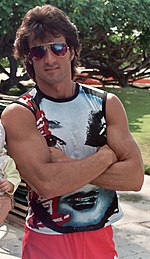
- In the early 1980s, fashion had moved away from the unkempt hippie look and overdressed disco style of the late 1970s. Athletic clothes were more popular than jeans during this period, as were more subdued colors. Popular colors were black, white, indigo, forest green, burgundy, and different shades of browns, tans, and oranges. Velour, velvet, and polyester were popular fabrics used in clothes, especially button-up and v-neck shirts. Looser pants remained popular during this time, being fairly wide but straight, and tighter shirts were especially popular, sometimes in a cropped athletic style. The general public, at this time, wanted to wear low-maintenance clothing with more basic colors, as the global recession going on at the time kept extravagant clothes out of reach.[7] Also worn were striped tube socks sometimes worn with the top folded over worn with shorts. It was not uncommon to see parents especially fathers wearing these along with their kids.
- Popular clothing in the early 1980s worn by men includes tracksuits,[38] v-neck sweaters, polyester and velour polo-neck shirts, sports jerseys, straight-leg jeans, jeans rolled to show off their slouch socks, polyester button-ups, cowboy boots,[39] beanies, and hoodies. Around this time it became acceptable for men to wear sports coats and slacks to places that previously required a suit.[7] In the UK, children's trousers remained flared, but only slightly.
New wave influence [edit]
- From the early to mid 1980s, post-punk and new wave music groups influenced mainstream male and female fashion. Commercially made slim-fitting suits, thin neckties in leather or bold patterns, striped T-shirts, Members Only jackets, clubwear, metallic fabric shirts, cat eye glasses, horn rim glasses with brightly colored frames, androgynous neon colored makeup,[40] and pristine leather jackets were widely worn.[41] Common hairstyles included a short quiff for men, or teased big hair for women, and typical unisex colors for clothing included turquoise, teal, red, neon yellow and white on a blue screen.
Preppy look [edit]
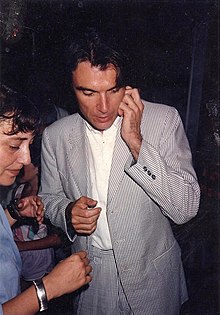
- In response to the punk fashion of the mid-late 1970s,[9] there was a throwback to the 1950s Ivy League style. This revival came to be definitively summarized in an enormously popular paperback released in 1980: The Official Preppy Handbook. Popular preppy clothing for men included Oxford shirts, sweaters, turtlenecks, polo shirts with popped collars,[9] khaki slacks, argyle socks, dress pants, Hush Puppies Oxford shoes, brogues, suspenders, seersucker or striped linen suits, corduroy, and cable knit sweaters that were often worn tied around the shoulders.[42]
Mid 1980s (1984–86) [edit]
Miami Vice/Magnum P.I. look and Michael Jackson's influence [edit]
- In the mid 1980s, popular trends included wool sport coats, Levi 501s, Hawaiian shirts, shell suits, hand-knit sweaters, sports shirts, hoodies, flannel shirts, reversible flannel vests, jackets with the insides quilted, nylon jackets, gold rings, spandex cycling shorts,[17] cowboy boots,[39] and khaki pants with jagged seams.[7]
- The mid 1980s brought an explosion of colorful styles in men's clothing, prompted by television series such as Miami Vice and Magnum, P.I.. This resulted in trends such as t-shirts underneath expensive suit jackets with broad, padded shoulders, Hawaiian shirts (complemented with sport coats, often with top-stitched lapels for a "custom-tailored" look), and (in counterpoint to the bright shirt) jackets that were often gray, tan, rust or white. Easy-care micro-suede and corduroy jackets became popular choices, especially those with a Western style.
- Michael Jackson was also a big influence of teenage boys' and young men's fashions, such as matching red/black leather pants and jackets, white gloves, sunglasses and oversized, slouch shouldered faded leather jackets with puffy sleeves.
Power dressing [edit]

1940s inspired pinstripe suit with large shoulder pads and double breasted fastening. These "power suits" were fashionable in Britain from the early 1980s until the late 1990s.
- Men's business attire saw a return of pinstripes for the first time since the 1970s. The new pinstripes were much wider than in 1930s and 1940s suits but were similar to the 1970s styles. Three-piece suits began their decline in the early 1980s and lapels on suits became very narrow, akin to that of the early 1960s. While vests (waistcoats) in the 1970s had commonly been worn high with six or five buttons, those made in the early 1980s often had only four buttons and were made to be worn low.[43] [44] The thin ties briefly popular in the early '80s were soon replaced by wider, striped neckties, generally in more conservative colors than the kipper ties of the '70s. Double breasted suits inspired by the 1940s were reintroduced in the 1980s by designers like Giorgio Armani, Ralph Lauren, and Anne Klein.[43] [44] They were known as 'power suits', and were typically made in navy blue, charcoal grey or air force blue.[43] [44] [45]
Tropical clothing [edit]

Mobutu wearing safari jacket, 1983.
- As an alternative to the power suit, the safari jacket, Nehru suit and Mao suit remained popular in Australia, South Africa, India, China, and Zaire, where it was known as an Abacost[46] and worn with a leopard print hat resembling the Astrakhan cap. At the same time, young African dandies known as sapeurs rebelled against the post-decolonisation government's suppression of Western fashions[47] by investing in expensive designer suits from Italy and France and listening to the soukous music of Papa Wemba.[48] This continued until the kleptocratic dictator Mobutu's deposition and death in the late 1990s, when the outbreak of a civil war in Zaire resulted in the sapeurs' disappearance until the 2010s.[49]
- In Hawaii, Aloha shirts and Bermuda shorts were worn on Aloha Fridays. By the end of the decade, when the custom of casual Fridays had spread to the US mainland, this outfit had become acceptable as daily Hawaiian business wear.[50] Elsewhere in the Caribbean and Latin America, especially Mexico, Ecuador, Colombia,[51] and Cuba, men wore the guayabera shirt for semi-formal occasions in imitation of the presidents Fidel Castro and Luis Echeverria.[52]
Late 1980s (1987–89) [edit]
Doc Martens [edit]

- Doc Martens were dark shoes or boots with air-cushioned soles that were worn by both sexes in the 1980s. They were an essential fashion accessory for the skinhead and punk subcultures in the United Kingdom. Sometimes Doc Martens were paired with miniskirts or full, Laura Ashley- style dresses.[53] They were an important feature of the post-punk 1980s Gothic look which featured long, back-combed hair, pale skin, dark eyeshadow, eyeliner, and lipstick, black nail varnish, spiked bracelets and dog-collars, black clothing (often made of gabardine), and leather or velvet trimmed in lace or fishnet material. Corsets were often worn by girls. British bands that inspired the gothic trend include The Cure, Siouxsie and the Banshees, and The Cult. This trend would return in the 1990s.
Parachute pants [edit]
Parachute pants are a style of trousers characterized by the use of ripstop nylon or extremely baggy cuts. In the original tight-fitting, extraneously zippered style of the late 1970s and early 1980s, "parachute" referred to the pants' synthetic nylon material. In the later 1980s, "parachute" may have referred to the extreme bagginess of the pant. These are also referred to as "Hammer" pants, due to rapper MC Hammer's signature style. Hammer pants differ from the parachute pants of the 1970s and early 1980s. They are typically worn as menswear and are often brightly colored. Parachute pants became a fad in US culture in the 1980s as part of an increased mainstream popularity of breakdancing.[54]
Unisex accessories [edit]
Jewelry

- Earrings became a mainstream fashion for male teenagers. Jelly or thin metal bracelets (also known as bangles) were very popular in the 1980s, and would be worn in mass quantities on one's wrist. Designer jewelry, such as diamonds and pearls, were popular among many women, not only for beauty, but as symbols of wealth and power.
Watches
- At the beginning of the decade, digital watches with metal bands were the dominant fashion. They remained popular but lost some of their status in later years. Newer digital watches with built-in calculators and primitive data organizers were strictly for gadget geeks. Adult professionals returned to dial watches by mid-decade. Leather straps returned as an option. By the late 1980s, some watch faces had returned to Roman numerals. In contrast, one ultramodern status symbol was the Movado museum watch. It featured a sleek design with a single large dot at twelve o'clock. The Tank watch by Cartier was a fashion icon that was revived and frequently seen on Cartier advertisements in print. Rolex watches were prominently seen on the television show Miami Vice. Teen culture preferred vibrant plastic Swatch watches. These first appeared in Europe, and reached North America by the mid-1980s. Young people would often wear two or three of these watches on the same arm.[ citation needed ]
Eyewear
- In the first half of the 1980s, glasses with large, plastic frames were in fashion for both men and women. Small metal framed glasses made a return to fashion in 1984 and 1985, and in the late 1980s, glasses with tortoise-shell coloring became popular. These were smaller and rounder than the type that was popular earlier in the decade. Throughout the 1980s, Ray-Ban Wayfarers were extremely popular, as worn by Tom Cruise in the 1983 movie Risky Business.[ citation needed ]
- Miami Vice, in particular Sonny Crockett played by Don Johnson, boosted Ray-Ban's popularity by wearing a pair of Ray-Ban Wayfarers (Model L2052, Mock Tortoise),[55] which increased sales of Ray Bans to 720,000 units in 1984.[56]
Subcultures of the 1980s [edit]
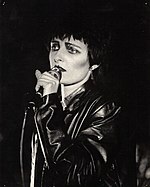
English singer Siouxsie Sioux wearing black clothing, back-combed hair, and heavy black eyeliner. She was an inspiration for the gothic fashion trend that started in the early 1980s.
Robert Smith of the Cure based his gothic look from Siouxsie Sioux's and being a guitarist in her band.
Heavy metal [edit]
- In the first half of the 1980s, long hair, leather rocker jackets (biker jackets) or cut-off denim jackets, tight worn-out jeans, and white, high trainers (sneakers) and badges with logos of favorite metal bands were popular among metalheads, and musicians of heavy metal and speed metal bands. However by the mid 1980s the success of the glam metal scene had influenced the style worn by many mainstream metal fans. In addition to the traditional denim and leather look, mainstream heavy metal bands began to dress in more bright, colourful and theatrical clothing similar, in many ways, to the glam rock look of the 1970s. This included items such as spandex, platform boots, leg warmers and many different types of often spiked or studded leather accessories. In addition to this the long hair popular with metal fans was often worn teased. Makeup became popular with many metal bands as well often worn onstage for theatricality however many bands also began wearing makeup offstage also. The mainstream glam metal image of the mid to late 1980s was often criticised by many underground metal fans as being too 'effeminate'. The mainstream glam metal (later called 'hair' metal) style would decline during the later half of the decade but would remain popular until the grunge movement in the early 1990s. In the second half of the 1980s, the original denim and leather clothing style was popular among musicians and fans of more extreme and niche (often underground) metal bands – thrash metal, crossover thrash, early black metal, and early death metal bands. It was popular particularly in the United States, but there were also large regional scenes in Germany, England, Canada, and Brazil. Although these styles of extreme metal would begin to adopt contrasting images during the ensuing decade.
- By the late 1980s, acid-washed jeans and denim jackets had become popular with both sexes. Acid washing is the process of chemically bleaching the denim, breaking down the fiber of material and forcing the dye to fade, thus leaving undertones of the original dye evidenced by pale white streaks or spots on the material. This became associated with the afformentioned heavy metal trend (called "hair metal" in later decades for the large frizzy coiffures worn by both male and female enthusiasts). Severely bleached and ripped jeans, either manufactured purposely or done by hand, become a popular fashion trend, being a main component of glam metal music acts such as Poison.
- The Japanese equivalent of glam metal, known as visual kei, emerged during the mid to late 80s and incorporated punk, goth and new wave influences.[57] Brightly dyed, androgynous hair was common among shock rock bands like X Japan, together with studded leather borrowed from fetish fashion, traditional Geisha or Japanese opera inspired makeup, drag,[58] and stylized 18th century fop rock costume such as frilly shirts, tall boots and long coats.[59]
Punk [edit]
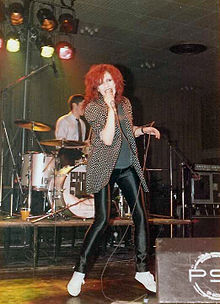
Wendy Wu, lead singer of the British new-wave band The Photos, in 1980.
- Throughout the 1980s, the punk style was popular among people aged 18–22. Characterized by multi-colored mohawks, ripped stovepipe jeans, worn band tee-shirts, and denim or leather jackets. This style was popular among people who listened to punk music such as The Sex Pistols, and later, (despite the band's self-proclaimed rock'n'roll image) Guns N' Roses. Usually the denim jackets (which became an identity of the group) were adorned by safety pins, buttons, patches, and several other pieces of music or cultural memorabilia. Oftentimes, fans of the punk style would take random bits of fabric and attach them to their other clothes with safety pins. This soon became a popular way of attaching clothing, and it is now known as "pin shirts" with young women. The shirts are, essentially, rectangular pieces of fabric that are pinned on one side with safety pins. In the 1980s, a dressed down look (e.g. buzzed hair, T-shirts, jeans and button up shirts) was also very popular with people involved in punk rock, more specifically the hardcore punk scene. The Circle Jerks frontman Keith Morris said "Some of those punk rock kids they interviewed were a little over the top, but the thing historically is – the L.A./Hollywood punk scene was basically based on English fashion. But we had nothing to do with that. Black flag and the Circle Jerks were so far from that. We looked like the kid who worked at the gas station or submarine shop."[60] Punk dress was not simply a fashion statement. It epitomized a way of thinking and seeing oneself as an individual cultural producer and consumer. In this way, punk style led many people to ask further questions about their culture and their politics.[61]
New Romantic [edit]
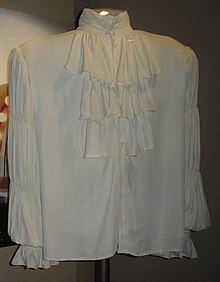
- The origins of the New Romantic and new wave fashion and music movement of the mid 1980s are often attributed to the Blitz Kids who frequented the club Blitz in London, especially David Bowie. Bowie even used the Blitz's host Steven Strange in his music video for Ashes to Ashes.[62] It is also important to note that the New Romantics and those involved with the punk scene had inspired each other because of the concentration of influential individuals going to the same clubs and having the same friend circles.[62] Vivienne Westwood & Malcolm McLaren were also directly involved in the movement, such as dressing the members of Bow Wow Wow. The band leader and later solo artist, Adam Ant, and Westwood had highly influenced each other as well (Adam Ant being one of the leading icons of the New Romantics).[63] Westwood's first runway collection, Pirates AW 1981-2 is often cited as a New Romantic collection which was both influenced by and highly influential to the movement. The garments in Pirates had asymmetrical necklines, flowy pirate shirts and breeches.[64] The collection was very well received by critics and buyers.[65] However, the designer's interference in the originally DIY fashion wasn't taken well by some of the participants, such as Boy George who left Bow Wow Wow to form his own band (Culture Club) and who cited one of the reasons for leaving as the way Vivienne Westwood wouldn't let him dress himself.[63]
- The Blitz Kids described the movement as a retaliation to punk[66] due to it becoming too violent and unsavory crowds such as neo-Nazis and skinheads deciding to jump on that aesthetic bandwagon.[62] It was also a way to forget their relative poverty following the economic recession and the Winter of Discontent.[66] Features of New Romantic clothing varied from individual to individual, although these generally highlighted the implied individualism, creativity and self-expression of the movement, besides its continued adherence to the DIY ethic of punk.[62] It was inspired by different cultures and time periods, films, film noir, and theatricality. Men often wore dramatic cosmetics and androgynous clothing, including ruffled poet shirts, red or blue hussar jackets with gold braid, silk sashes, tight pants, shiny rayon waistcoats, and tailcoats based on those worn during the Regency era. Women, too, were very theatrical in terms of makeup and style, and often favoured big hair, fishnet gloves, corsets, crushed velvet, and elements of Middle Eastern and gypsy clothing.[63]
Rockabilly [edit]
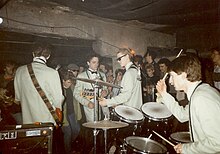
- In the early 1980s, the Teddy Boy look was popular in the UK among fans of groups like the Stray Cats, Crazy Cavan, Levi and the Rockats, or Shakin Stevens. Common items of clothing included drape jackets (generally in darker shades than those of the 1970s), drainpipe trousers, brothel creepers, bolo ties, white T-shirts, baseball jackets, hawaiian shirts, and black leather jackets like the Schott Perfecto. Common hairstyles included the quiff, pompadour, flat top, and ducktail.
- The French rockabilly scene of the early to mid 80s was closely linked with the street punk subculture, had a large black and Arab following, and was involved with antifascist squaddism.[67] The Black Dragons identified themselves with the leather jacket wearing greaser antiheroes, rebels and outcasts, and often fought the neonazi skinheads.[68]
Rude boys and skinheads [edit]

British skinheads in 1981
- Following on from the mod revival of the late 70s, the UK witnessed a revival of rude boy and skinhead fashion due to the popularity of ska punk, Oi! punk rock, rocksteady, and two tone music during the winter of discontent. In the early 80s, slim fitting mohair, tonic and houndstooth suits[69] were popular, together with basket weave shoes, polo shirts, sta-prest trousers, Doc Martens, braces, Harrington jackets and pork pie hats popularized by bands like the Specials, UB40, the Bosstones, and Madness.[70] In response to the racism of white power skinheads, 1980s rude boys wore checkerboard motifs to signify that both black and white people were welcome. Crew cuts and buzzcuts were worn by both sexes,[71] and girls often incorporated hair bangs in a partially shaven style known as a Chelsea mohawk.[72] In Brighton, the Skins of the 1980s fought the outlaw bikers and rockabilly guys, as the Mods and Rockers had previously done in the 60s.
Casuals [edit]
- The football casual subculture first appeared in the UK around 1983, when many ex-skinheads began dressing in designer clothing and sportswear to blend into the crowd and avoid police attention at football games. Popular clothing for English and Scottish casuals included Burberry coats, Stone Island, Lacoste, Ben Sherman and Fred Perry polo shirts, tracksuits,[73] bomber jackets, Adidas, Nike, or Reebok sneakers, Fila or Ellesse jackets, flat caps, baseball caps, soccer shirts, and scarfs or bobble hats in their club's colours.[74] Although shaved heads[75] [ self-published source? ] remained the most common haircut, some fans also wore undercuts, Caesar cuts, mod haircuts, and short mullet haircuts. During the late 80s, Casuals mostly listened to acid house, new wave music, and later indie rock[76] or Madchester[77] but a hip-hop influenced offshoot of the subculture, known as chavs, appeared during the late 1990s and early 2000s.[78] [79]
Skaters [edit]

- In Russia,[80] Australia, East Germany,[81] and America, the skater subculture reached the height of popularity in the mid 80s. Unlike the hippie and surfer influenced skaters of the 70s, the skaters of the 80s overwhelmingly preferred sportswear and punk fashion, especially baseball caps, red waffle plaid shirts, sleeveless T-shirts, baggy pants or Jams[82] shorts resembling pajamas,[83] checkered wristbands, striped tube socks, and basketball shoes like Converse All Stars and Vans. Brightly colored T-shirts became fashionable by the end of the decade, often featuring psychedelic eyes, skulls, Ed Roth inspired cartoon characters, palm trees, iron crosses, or the logos of skateboard brands like Stussy,[84] Tony Hawk, Mooks or Santa Cruz.[85] The longer surfer hair was replaced with edgy hardcore punk and street punk inspired styles like the bowl cut or Hitler Youth haircut.
Rap and hip hop [edit]


- Sports shoes had been worn as casual wear before, but for the first time they became a high-priced fashion item. Converse shoes were popular in the first half of the 1980s. In 1984, Nike introduced the first ever Air Jordan sneaker, the Air Jordan 1 (named for basketball player Michael Jordan). Although most believe this shoe was banned by the NBA due to the sneaker being too flashy and distracting, others believe it was actually, the predecessor, the Nike Air Ship that was under scrutiny.[86] Nike used this controversy between Air Jordan and the NBA to market the sneaker. The Air Jordan 1 was released in the royal blue color way to the public in 1985 and was an immediate success, still retaining its value in the fashion world today.[87] Soon, other manufacturers introduced premium athletic shoes.
- Adidas sneakers were also a successful brand of the decade, becoming popular among teenage boys and young men.[ citation needed ] The growth of pop-culture and hip-hop influence allowed group Run-D.M.C. to make the Adidas Superstar (commonly known as the shell toe) one of the most sought-after shoes of the 1980s. Following their single "My Adidas", Adidas reportedly gave them $1 million endorsement deal.[88] Nike had a similar share of the market, with the Air Max and similar shoes such as the Air Force One which was released in 1982. High-tops, especially of white or black leather, became popular. Other sportswear brands released popular shoes - Reebok had the Reebok Pump, Converse released the Cons and New Balance had the Worthy 790.
- In the early 1980s, long and white athletic socks, often calf-high or knee-high, were worn with sneakers. As the decade progressed, socks trended shorter, eventually topping out just above the height of the shoe.[ citation needed ] Run-D.M.C. and other hip-hop groups also influenced the apparel industry. Wearing track suits and large chains necklaces, they popularised sportswear brands such as Fila, Puma, Reebok, Nike, Avia and Adidas.[89] Individuals in the culture also frequently wore bucket hats, oversized jackets and t-shirts, and high contrast colors.[90] Fashion in hip-hop was a way to surpass the poverty that surrounded the community.[91]
- According to Chandler and Chandler-Smith (2008), rap and hip-hop were not one specific style, but rather a mix between high-end luxury fashion and what was on the street.[92] Harlem designer and shop-owner Dapper Dan embodied this concept by redesigning luxury products and making them available to those who wouldn't typically associate themselves with it. Dapper Dan was most famous for deconstructing a Louis Vuitton garment and turning it into his signature jacket. He reconstructed garments for many music icons and celebrities in the 1980s before getting shut down by lawyers in the early 1990s.[93] This interest in luxury apparel expanded past Dapper Dan - American fashion brands Tommy Hilfiger, Ralph Lauren, and Nautica were expanding rapidly and embraced by hip-hop culture as an indicator of status.[89]
- Ensembles featuring the Pan-African colors - green, yellow and red, and red, black and green - became popular among African Americans, as did kente cloth. In the urban hip-hop communities, sneakers were usually worn unlaced and with a large amount of gold jewelry, as well as head wraps.[ citation needed ]
Preppy [edit]

Young Iranian men wearing casual preppy outfits in 1981
- Wealthy teenagers, especially in the United States, wore a style inspired by 1950s Ivy League fashion that came to be known as "preppy." Preppy fashions are associated with classic and conservative style of dressing and clothing brands such as Izod Lacoste, Brooks Brothers, and Polo Ralph Lauren.[94] An example of preppy attire would be a button-down Oxford cloth shirt, Ascot tie, cuffed khakis, and tasseled loafers, Keds, Boat shoes, or ballet flats. Throughout the 1980s and 1990s, preppy fashions featured a lot of pastels, turtleneck sweaters for girls, knee high socks sometimes turned down or folded over at the top with above the knee length skirts and dresses and polo shirts with designer logos. Other outfits considered "preppy" included cable knit cardigans or argyle pattern sweaters tied loosely around the shoulders,[95] dress shorts with knee socks, dressed up leggings outfits from the mid 80's on which consisted of leggings with an oversized v-neck sweater over a turtleneck, slouch socks, Keds (shoes) or Sperrys, and bangs with a headband band or ponytail and scrunchie. The European equivalent, known as Sloane Rangers, dressed similarly but frequently incorporated tweed cloth British country clothing, burberry mackintoshes, mustard corduroy pants, rain boots, padded hairbands, and ancestral jewellery such as pearl necklaces.[96]
Hairstyles [edit]
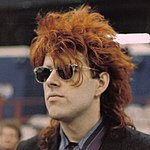
Women's hairstyles [edit]
Although straight hair was the norm at the beginning of the decade, as many late-1970s styles were still relevant, the perm had come into fashion by 1980.
Big and eccentric hair styles were popularized by film and music stars, in particular among teenagers but also adults. These hairstyles became iconic during the mid 1980s and include big bangs worn by girls from upper elementary, middle school, high school, college and adult women. There was generally an excessive amount of mousse used in styling an individual's hair, which resulted in the popular, shiny look and greater volume. Some mousse even contained glitter.
Beginning in the late 80s, high ponytails, side ponytails, and high side ponytails with a scrunchie or headband became common among girls from upper elementary, middle school, high school, college and adult women.
Men's hairstyles [edit]
By 1983, short hair had made a comeback for men, in reaction to the shag and mod haircuts of the mid to late 70s. The sideburns of the 1960s and 1970s saw a massive decline in fashion, and many guys wore regular haircuts and quiffs. Beards went out of style due to their association with hippies, but moustaches remained common among blue collar men.
From the mid 1980s until the early 1990s, mullets were popular in suburban and rural areas among working-class men. This contrasted with a conservative look preferred by business professionals, with neatly groomed short hair for men and sleek, straight hair for women. Some men also wore bangs in styles such as regular frontal or side swept bangs but they were not as big as women or girls bangs. Hairsprays such as Aqua Net were also used in excess by fans of glam metal bands such as Poison.
During the late 80s, trends in men's facial hair included designer stubble.
Image gallery [edit]
-

Girl in 1980.
-

A French punk, 1981.
-
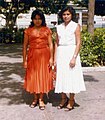
-

-

Lady Diana in 1985 wearing a dress with shoulder pads.
-

-

-

Group of friends in Italy in 1987.
-

-

-

See also [edit]
- 2000–2009 in fashion
- 1990s in fashion
- 1970s in fashion
Notes [edit]
- ^ Browne, Ray B.; Browne, Pat (15 June 2001). The Guide to United States Popular Culture. Popular Press. pp. 357–. ISBN978-0-87972-821-2 . Retrieved 11 August 2012.
- ^ Lauraine Leblanc. Pretty in Punk: Girls' Gender Resistance in a Boys' Subculture. Rutgers University Press, 1999. P. 52
- ^ Brubaker, Ken (9 October 2003). Monster Trucks. MotorBooks International. p. 64. ISBN978-0-7603-1544-6 . Retrieved 10 August 2012.
- ^ Welters, Linda; Cunningham, Patricia A. (20 May 2005). Twentieth-Century American Fashion. Berg. pp. 223, 337. ISBN978-1-84520-073-2 . Retrieved 10 August 2012.
- ^ Bateman, Antony; Benyahia, Sarah Casey Casey; Mortimer, Claire (23 May 2012). AS Media Studies: The Essential Introduction for WJEC. Routledge. p. 111. ISBN978-0-415-61334-7 . Retrieved 10 August 2012.
- ^ Steinberg, Shirley R.; Kehler, Michael; Cornish, Lindsay (17 June 2010). Boy Culture: An Encyclopedia. ABC-CLIO. p. 95. ISBN978-0-313-35080-1 . Retrieved 10 August 2012.
- ^ a b c d e f g h i j k l m n "Fashion in the 1980s". Retrieved 24 April 2014.
- ^ a b "Designer Jeans". Retrieved 7 July 2014.
- ^ a b c "VH1 – I Love The 80s – 1980". Retrieved 9 July 2014.
- ^ Alexander, Ron (1980-06-01). "'Jelly Shoes' In Brash Colors". The New York Times. (complete text)
- ^ "Sex Bracelets". Retrieved 9 June 2014.
- ^ "Sweatshirts". Retrieved 9 July 2014.
- ^ a b "Leg Warmers". Retrieved 7 July 2014.
- ^ Roland, James. "The History of the Basketball Shoe | LIVESTRONG.COM". Retrieved 2015-05-03 .
- ^ "Trainer Shoes". Retrieved 3 September 2014.
- ^ "Footwear, 1980–2003". Retrieved 3 September 2014.
- ^ a b "Spandex". Retrieved 9 July 2014.
- ^ "Fashion in the 1980s, Social and cultural features of the 1980s, Australia's social and cultural history in the post-war period, History Year 9, NSW | Online Education Home Schooling Skwirk Australia". Skwirk.com.au. 1999-03-26. Archived from the original on 2013-11-12. Retrieved 2014-05-10 .
- ^ Technology and Living – Fashion, Clothing and Textiles Strand (Vol. 6 Culture and Fashion Design). Hong Kong Education Bureau. 2009.
- ^ "Power Dressing 1980s Fashion History. Fashion-Era". Tomas, P. 2015.
- ^ "1980s Fashion History and Lifestyle. Fashion-Era". Tomas, P. 2015.
- ^ "1989 Sears Wishbook". www.wishbookweb.com . Retrieved 2017-07-25 .
- ^ "1989 Sears Wishbook". www.wishbookweb.com . Retrieved 2017-07-25 .
- ^ "Mao suit". depts.washington.edu.
- ^ Montefiore, Clarissa Sebag. "From Red Guards to Bond villains: Why the Mao suit endures".
- ^ "Chinese girl in yellow".
- ^ "Modernity that is cladded on". Archived from the original on 2016-03-31. Retrieved 2016-01-21 .
- ^ "Chinese 70s fashion". Archived from the original on 2016-03-31. Retrieved 2016-01-21 .
- ^ Crossette, Barbara (21 June 1989). "New Fashion School in India Draws From a Rich Heritage". The New York Times.
- ^ Indian fashion's greatest hits Archived August 3, 2013, at the Wayback Machine
- ^ Mendes, Valerie D.; Haye, Amy De La (17 September 1999). 20th Century Fashion . Thames & Hudson. ISBN9780500203217 – via Internet Archive.
- ^ Jordan, Patti (1 September 2017). "Gender fluidity in men's fashion: From Shakespeare's modern English to the new millennium". Critical Studies in Men's Fashion. 4 (2): 171–184. doi:10.1386/csmf.4.2.171_1.
- ^ a b Sun, Tiantian (May 2013). East Meets West: The Influence from Japanese Traditional Kimono to 1980s Japanese Fashion Designers and Further Influence Western Fashion (Thesis).
- ^ Japanese fashion in the Met Museum
- ^ "The Cutting Edge: Fashion From Japan". designtaxi.com.
- ^ "2013 - Volume 40 - Google Drive". drive.google.com. [ full citation needed ] [ unreliable source? ]
- ^ a b "The Japanese Revolution in Paris Fashion, Yuniwa Kawamura". www.transitionandinfluenceprojects.com. [ unreliable source? ]
- ^ Craik, Jennifer (2005). Uniforms Exposed (Dress, Body, Culture). Oxford, UK: Berg Publishers. p. 171. ISBN1-85973-804-4.
- ^ a b "Cowboy Boots". Retrieved 9 July 2014.
- ^ "New wave makeup".
- ^ "Totally 80s: New Wave". Archived from the original on 7 January 2015. Retrieved 4 October 2014.
- ^ "80s' Fashion for Men". Retrieved 20 May 2014.
- ^ a b c Fashion and style. "The rehabilitation of the power suit". Telegraph. Retrieved 2014-05-10 .
- ^ a b c "The History of the Power Suit ~ Levo League". Levo.com. 2014-03-06. Archived from the original on 2014-05-13. Retrieved 2014-05-10 .
- ^ "Power Suit – Voguepedia". Vogue.com. Archived from the original on 2014-02-02. Retrieved 2014-08-12 .
- ^ "Mode : les nostalgiques des années 70 exhument l'Abacost - adiac-congo.com : toute l'actualité du Bassin du Congo". adiac-congo.com.
- ^ Congo sapeur fashion
- ^ "Les Sapeurs: Bringing subversive style to the Eastern Congo".
- ^ Doig, Stephen (17 September 2018). "Meet the dandies of Brazzaville" – via www.telegraph.co.uk.
- ^ Brown, DeSoto; Linda Arthur (2002). The Art of the Aloha Shirt. Island Heritage Publishing. ISBN 0-89610-406-0. Page 79
- ^ Restrepo, Laura (17 September 1986). Colombia, historia de una traición. IEPALA Editorial. ISBN9788485436347 – via Google Books.
- ^ "History of Miami". Archived from the original on 2012-07-21. Retrieved 2016-04-25 .
- ^ Fashion-Era.com
- ^ Mansour, David (June 2005). "Parachute pants". From Abba to Zoom: A Pop Culture Encyclopedia of the Late 20th Century. p. 353. ISBN9780740751189 . Retrieved 13 January 2011.
- ^ "South Beach and 'Miami Vice,' past and present". USA Today. www.usatoday.com. 2006-09-29. Retrieved 2007-11-25 .
- ^ Leinster, Colin (1987-09-28). "A Tale of Mice and Lens". Fortune Magazine. money.cnn.com. Archived from the original on 31 October 2007. Retrieved 2007-11-25 .
- ^ Strauss, Neil (18 June 1998). "THE POP LIFE; End of a Life, End of an Era". The New York Times.
- ^ "Japanese Rock on NPR".
- ^ Hughes, Felicity (26 October 2010). "Scene and heard: Visual kei". The Guardian.
- ^ Prindle, Mark. "Keith Morris – 2003". Interview. Mark Prindle. Retrieved 2013-10-20 .
- ^ Mattson, Kevin (Spring 2001). "Did Punk Matter?; Analyzing the Practices of a Youth Subculture During the 1980s". American Studies. 1. 42 (1): 77. JSTOR 40643156.
- ^ a b c d [Strange, S., & Egan, R. (2010, May 15). It's blitz: Birth of the new romantics (Interview by P. Elan). The Guardian. Retrieved from https://www.theguardian.com/music/2010/may/15/blitz-boy-george-steve-strange-visage ]
- ^ a b c Bromley, I., & Wojciechowska, D. (2008). Very vintage: The guide to vintage patterns and clothing. London, UK: Black Dog.
- ^ History: Early years. (2017). Retrieved April 10, 2017, from Vivienne Westwood website: http://www.viviennewestwood.com/en-gb/history/early-years Archived 2017-04-20 at the Wayback Machine
- ^ Mendes, V., & de la Haye, A. (2010). Thames&Hudson world of art: Fashion since 1900s (2nd ed.). Thames & Hudson. (Original work published 1999)
- ^ a b crane.tv. (2013, July 11). Club to catwalk | Blitz kids [Video file]. Retrieved from https://www.youtube.com/watch?v=hkeM_-wVgWU
- ^ "Black Dragons: The Black Punk Gang Who Fought Racism & Skinheads in 1980s France". 10 August 2016.
- ^ "Chasing Skinheads with the Black Dragons in 1980s Paris". 29 July 2015.
- ^ Misiroglu, Gina (26 March 2015). American Countercultures: An Encyclopedia of Nonconformists, Alternative Lifestyles, and Radical Ideas in U.S. History: An Encyclopedia of Nonconformists, Alternative Lifestyles, and Radical Ideas in U.S. History. Routledge. ISBN9781317477297 – via Google Books.
- ^ Augustyn, Heather (10 January 2014). Ska: An Oral History. McFarland. ISBN9780786461974 – via Google Books.
- ^ Augustyn, Heather (12 September 2013). Ska: The Rhythm of Liberation. Scarecrow Press. ISBN9780810884502 – via Google Books.
- ^ "The rise of the Skinhead: Photos document the controversial youth cult - Page 3 of 3". 10 July 2016. Archived from the original on 2 February 2017. Retrieved 27 January 2017.
- ^ Solomons, Jason (13 August 2005). "Casual dress essential". The Guardian.
- ^ "Emotional hooliganism".
- ^ Gough, Meic (1 April 2007). Patches Checks and Violence. Lulu.com. ISBN9781847531865 – via Google Books. [ self-published source ]
- ^ The Scotsman
- ^ "Football Casuals- 80s Casuals". www.football-hooligan.com.
- ^ "Burberry versus The Chavs". 28 October 2005 – via news.bbc.co.uk.
- ^ Daubney, Martin (25 February 2015). "White male football fans: the scum it's great to hate" – via www.telegraph.co.uk.
- ^ "Skate USSR: discover the Soviet subculture you never knew existed".
- ^ "East Germany's Secret Police Used to Spy On Skateboarders". 26 November 2013.
- ^ "Jams Shorts – an 80s summer fashion must have for both men and women!". 22 May 2010.
- ^ Moore, Jennifer Grayer (14 December 2015). Fashion Fads Through American History: Fitting Clothes into Context: Fitting Clothes into Context. ABC-CLIO. ISBN9781610699020 – via Google Books.
- ^ "How skaters fell from fashion". The Age. 11 January 2003.
- ^ Vintage T-shirts
- ^ "Jordan 1 Banned Complete History | SneakerNews.com". Sneaker News. 2016-09-01. Retrieved 2017-10-07 .
- ^ Martin, Jake Woolf, Matt (2017-03-31). "The Air Jordan 1 "Royal" From 2001 Is Still the Best—Here's Why". GQ . Retrieved 2017-10-07 .
- ^ "How Has Hip Hop Influenced Fashion? | LEAFtv". LEAFtv . Retrieved 2017-10-07 .
- ^ a b "How Rappers Took Over Fashion | Highsnobiety". Highsnobiety. 2017-10-07. Retrieved 2017-10-07 .
- ^ Sacasa, Edwin (2013). Shirt Kings: pioneers of hip hop fashion. Arsta: Dokument Press. ISBN9789185639571.
- ^ Cochrane, Lauren (2015-10-27). "So fresh and so clean: a brief history of fashion and hip-hop". The Guardian. ISSN 0261-3077. Retrieved 2017-10-07 .
- ^ Chandler, Robin (2008). Flava in Ya Gear: Transgressive Politics and the Influence of Hip-Hop on Contemporary Fashion. Cunningham: L. Welters & P.A.
- ^ Cooper, Barry Michael (2017-06-03). "The Fashion Outlaw Dapper Dan". The New York Times. ISSN 0362-4331. Retrieved 2017-10-07 .
- ^ Peterson, Amy T., and Ann T. Kellogg (2008). The Greenwood Encyclopedia of Clothing Through American History 1900 to the Present: 1900–1949. ABC-CLIO. p. 285. ISBN 9780313043345
- ^ "camillereads.com". www.camillereads.com.
- ^ Jardine, Cassandra (3 October 2007). "Ann Barr: The woman who invented Sloanes" – via www.telegraph.co.uk.
References [edit]
- John Peacock, Fashion Sourebook: The 1980s, ISBN 0-500-28076-2 (October 1, 1998)
- Tom Tierney, Great Fashion Designs of the Eighties, ISBN 0-486-40074-3 (March 18, 1998)
- Catherine McDermott, Made in Britain: Tradition and Style in Contemporary British Fashion, ISBN 1-84000-545-9
- Breward, Christopher, Fashion, ISBN 0-19-284030-4 (June 1, 2007)
External links [edit]
- Children's clothing from the 1980s
- "1980s – 20th Century Fashion Drawing and Illustration". Fashion, Jewellery & Accessories. Victoria and Albert Museum. Archived from the original on 8 January 2011. Retrieved 2011-04-03 .
What Colors Were Popular in the 1980s
Source: https://en.wikipedia.org/wiki/1980s_in_fashion